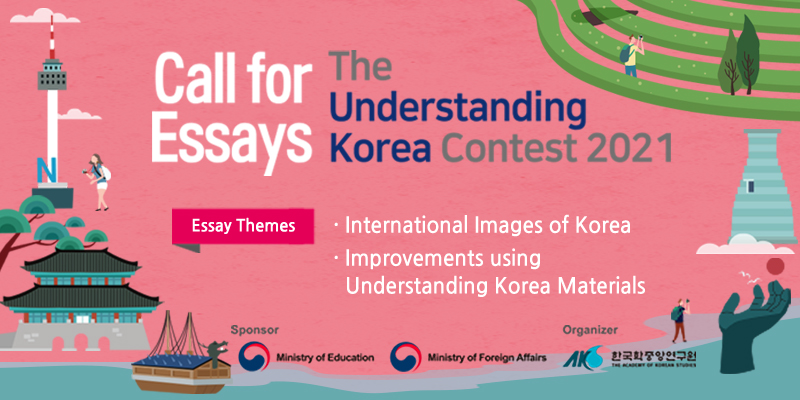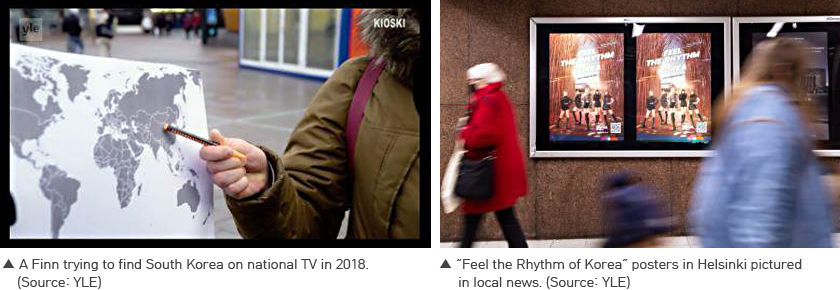Essay Contest Result

21st Century South Korea: image-building through the grassroots level
Few could have predicted the rise of South Korea as a global cultural center just a few decades ago, but Korea's status has gone through a rapid change in a short period. Still, the image of Korea can be overshadowed by its neighboring rising China and culturally powerful Japan. For average people looking at the region from afar, it can be difficult to differentiate between these countries: as understood through the concept of attention economy, each individual is limited in their time of understanding the world. For Korea, I believe its image is unavoidably in competition with those of China and Japan in the minds of many people outside Asia. While Korea's position has certainly risen lately and it is currently the highest it's ever been, there is still much work that can be done to further cement Korea's place in the minds of the people across the world.
In my home country of Finland, Korea is still defined for many people through the everpresent images of North Korea in the media – years ago as I went through high school, the Korean War was the only time Korea was mentioned during education at all, for example. While this is likely changing for the younger generations through recent cultural breakthroughs like BTS or Parasite, the average Finn is still likely to be ignorant about Korea. For example, in a short segment made by the national Finnish Broadcasting Company (YLE) about South Korea in the run up to PyeongChang Olympics, some of the street interviewees, both young and old, struggled to even place Korea on the world. To enhance further spread of information about Korea, in this essay I'm suggesting a new approach towards public diplomacy to supplement current projects.
In my home country of Finland, Korea is still defined for many people through the everpresent images of North Korea in the media – years ago as I went through high school, the Korean War was the only time Korea was mentioned during education at all, for example. While this is likely changing for the younger generations through recent cultural breakthroughs like BTS or Parasite, the average Finn is still likely to be ignorant about Korea. For example, in a short segment made by the national Finnish Broadcasting Company (YLE) about South Korea in the run up to PyeongChang Olympics, some of the street interviewees, both young and old, struggled to even place Korea on the world. To enhance further spread of information about Korea, in this essay I'm suggesting a new approach towards public diplomacy to supplement current projects.

The Bottom-up Approach
While general image-building is important and has its place in increasing knowledge about a country, it has its limits for growing long-term interest. In the more general form, South Korea is already fairly strong: even if people have little interest of the country, most people can probably tell that South Korea is a developed, democratic country with high cultural influence and a home of many well-known brands. This is what can be called passive engagement: it does not necessarily drive many people to want to know more about or go to Korea, but it builds the country-image for a very wide audience. This form of general knowledge is important, as it functions as the foundation for any new information to be built on.What I would suggest being more important, however, is to create more active and longlasting forms of active engagement towards South Korea. To establish deep and genuine interest in Korea, people need personal connection. Perhaps the most important aspect is connecting with people in ways that are natural and do not feel forced. Large institutions often fail at this, and especially in the cases of state agencies, people are naturally suspicious of information that feels too much like top-down "propaganda" with an agenda. On the other hand, information becomes more accessible and easier to digest when it comes in ways that the target audience is either already familiar with or from a source who they can easily relate with.
While globalization has been the buzz word of the 21st century and the information technology has advanced almost enough to make long distances disappear altogether, it is easy to forget the importance of the local in people's everyday lives. The other side of technological progress has been the increasingly individualized experiences, and the decentralization and democratization of information itself. With each individual being more and more able to exist in their private, particular experience, it is at this level that people are most open to new information and experiences. The first move in image-creating should, therefore, always be specifying a very limited target audience that are meant to be receiving the information. When it is well known what a group wants to see and how they usually engage with content, the images they are sent can be customized to fit their needs and to ensure high interest.
One issue with this type of grassroots approach is that it cannot really be forced: there has to be a basic level interest and organization to begin with. Fortunately, the Korean wave has washed through every nation in the world, making it possible to find passionate Korea fans almost anywhere. Using Finland as an example, there are multitudes of language, food, and culture classes available for those interested. There are Korean lectures in various educational institutions, cultural events like concerts, and there are stores focusing on Korean merchandise or cosmetics. There are also online influencers discussing all aspects of Korea with their followers. Most of these are run by local Finnish individuals or organizations, and these are the places where I would see institutional support directly from Korean institutions to be most useful and cost-efficient in further building the image of Korea. The people working on these projects mostly do so on basis of their own passions, and they naturally know the local audience in terms of language, culture and demand – aspects that would take a lot of effort and costs for any "outsiders" to master. Their networks are already familiar with some aspects of South Korea and they are, therefore, a prime target for further imagebuilding. These people will also spread their understanding of Korea to people around them, as it is built on truly genuine interest rather than any gimmicks.
Looking at some of the recent official South Korean materials can help in highlighting the difference between the general approach and what I'm advocating here. One of the more recent campaigns was the Feel the Rhythm of Korea that emerged in 2020 with a number of viral YouTube videos introducing various Korean cities. The campaign was also visible in Finland, with posters on the street around Helsinki. Seemingly a success, at least by standard of video views, this type of advertising definitely goes in to the category of general imagebuilding. The videos and posters showcase the variety of Korea and build on the popular strengths of Korea, such as music, tradition, and nature. This type of content is easy to send all over the world, but it is hardly enough to really cultivate a long-term interest or concrete response: it only creates a positive image in a passive sense. Similarly, the Understanding Korea materials are helpful in the strict educational sense but are unlikely to inspire passionate responses: it is material to be taught in an educational setting, but not something to be discovered privately.
When information is integrated into daily entertainment and social media content, the content becomes more natural and spontaneous, something to get interested in by one's own accords rather than something aimed down from an authority. While both approaches are necessary, so far the focus has been far more on the general materials. What could be some concrete examples of where this type of active engagement can be used? One familiar field to me is that of esports. It is a field with a lot of growth potential and has many grassroots organizations across the world, and a deep history with South Korea. Esports is a good example of a field where it makes sense to take advantage of the already existing infrastructure and organizations. My own interests towards Korea grew through watching esports, and I know many like me. Still, there was never much outreach to this audience by official institutions, and even the Korean companies engaged with the scene tended to treat the foreign audiences as an afterthought. An esports event would attract people who are already open to gaining information about Korea, and then could function as a vehicle to deliver them contents in a context they trust and are familiar with. Similar other niche interests are numerous, and they all have great potential for promoting Korea for relatively little effort and cost.
In the fast-moving internet era, information needs to also feel fresh and move quickly: even a yearly update tends to be viewed as outdated. This is, of course, somewhat context dependent (information on food will last much longer than information about music, for example), but it is still worth considering. Here, it is social media influencers that might prove most useful in delivering consistent and up-to-date content. Viewers of YouTube or TikTok content creators are used to a constant stream of information on a daily or weekly basis and using these channels as intermediaries for image-creating is far more efficient than trying to build such channels from the zero. The content creators themselves would likely also be open to working together with Korean institution, creating a win-win situation for all sides.
While it can be tempting to invest for new gimmicks utilizing flashy technology, such as creating apps, video series or games, they often run short of their potential and cost, quickly becoming outdated and awkward for normal viewers have learned to be wary of such promotions. Instead, it is still the natural everyday situations that really make up memories and impressions that stay with people for the long-term and help to create positive associations that can be transform into life-long engagement and interest. Rather than trying to create generalized, large-scale campaigns, institutions wanting to promote South Korea should work together with the numerous passionate individuals across the world to utilize their already existing, naturally grown platforms to spread correct information about the country.
As the world slowly reopens in the coming years following the COVID-19 pandemic, it is a critical time to create new impressions about South Korea. With its high level of technological advancement and cultural importance, South Korea stands at the forefront of the potential for utilizing new, 21 st century methods of national image-building and public diplomacy.

